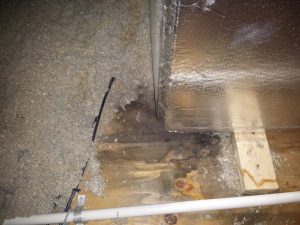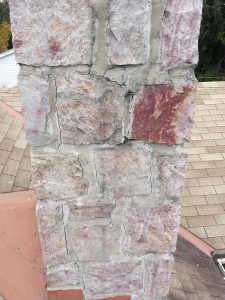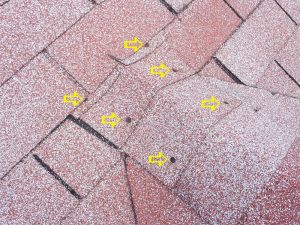When searching for the cause of a roof leak, a lot of time can often be saved by gathering as much information as possible about the leak before going up on the roof.
Here are some questions to ask to help in determining the cause and severity of the leak: How long have you had the roof leak? Does it appear worse on a heavy rain? Does it leak after a snow or ice buildup? Does it only leak from a directional rain?
If possible, is best to ask to see the actual leak area rather than just going by the customer’s evaluation. I have had customers try to describe a leak in a particular room and then direct me to look on the wrong end of the house. Measure from the leak area in relation to the nearest window (if possible) and take note of window locations so when you head back outside, you will be able to best pinpoint the leak area. While investigating the leak, keep in mind that an interior stain on a ceiling, or even an active dripping can be caused by a number of factors.

Sometimes, a roof leak isn’t always a roof leak. Water damage is not always caused by a issue with the roof. Condensation and or leaking from interior plumbing or air conditioning unit can often be a cause. I have found cracked cast iron bathroom vent pipes to be the cause of leaks on at least two separate occasions. Moisture buildup from lack of ventilation in an attic has also been an interior cause. An active leak while the weather is dry could also still be a roof leak. Soaked insulation can leak through a ceiling for quite a bit of time before drying up. Some leaks are caused by what is referred to as “ice dam”. As snow and ice melts and re-freezes, a dam is formed near the bottom of the roof, causing melting water to work its way under seams in the roof, causing leaks. The cause of ice dams is usually poor insulation in the the roof rafters.
Another point to consider is that what a customer thinks is an active leak, may not be active. Many times a leak will have been repaired long ago, but a customer just thinks the leak is still active because the staining still remains. If you think this is the case, mark the outer stain rings with pencil or chalk. Go back and check after a heavy rain or two. If the roof leak is still active, the stains will have grown outside of your markings. If not, the stains are most likely old, and the leak has already been corrected.
Here are some common roof leak water entry points:
Valleys:
Copper valleys will wear thin, producing pinholes that will continue to grow as the copper deteriorates.
If not painted, metal valleys wear out much faster than copper, also starting with pinholes that will continue to rust through.
Flashings:
Check flashing along walls,chimneys and other protrusions for wear, damage, or improper installation.
Vent Pipes:
Rubber gaskets around vent pipes will quickly crack and deteriorate causing leaks. Vent pipes are often found above kitchens and bathrooms, and should definitely be checked when leaks are in those areas.

Chimneys:
If the leak is near a chimney, the chimney itself could possibly be the leak culprit. Check the flashing where the chimney meets the roof, check the mortar joints, check the top of the chimney, and if possible, look down inside the chimney. Looking inside, you may find that the terracotta chimney flue pieces may be cracked or offset, allowing rain to seep into the house. A chimney cap would be a simple fix unless the chimney needs extensive masonry work.


Exposed Nail heads:
Water has a way of working down nail heads, so any exposed nails will be potential leak.

Hips and Ridges- Although the hips and ridges of the roof receive the least amount of rain, they can still be the location for leaks. On asphalt roofs, problems with the ridge vent can often be a cause for leaks a the peak of a roof. For slate roofs, the house will often settle, causing the ridge and/or hip slates to separate, causing a gap.
Gutters- Improperly installed gutters or clogged gutters can sometimes be the source of a leak.
Siding- Damaged or improperly installed siding can possibly be the source of a leak.
Traveling leaks- Sometimes the entry point of the leak on the exterior of the house will be in a different location than where the leak is showing up on the inside. Water can travel quite a distance along rafters and down the roof deck before dripping down leaking into living space. Water can even migrate sideways along tongue-and-groove decking.
Asphalt Shingles- Sloppy roofing, especially from crews using nail guns, is a great cause for exposed nails. Look for nails installed too low (either visible below the shingle, or just under the shingle). Water will wick under the edge of shingles, especially on shallow pitched roofs. You may have to lift shingles in the leak area to find where nails were installed too low. If you find rusty nail heads, you may have found your leak. Another tricky leak is when the nail is in a seam. This is also caused by a careless roofer. These are hard to see, and may also require lifting shingles in the leak area to find the culprit. Asphalt shingles can crack from age, from loose roof decking, or from building movement.
Slate: The weight of snow/ice,human foot traffic, or even house movement can cause nail heads to pop up through slate. Poor repairs, such as “face-nailing” or nailing directly though a slate can be the cause of leaks. At the very least, any exposed nail heads on a slate roof should be repaired or replaced. Sliding slates should be checked and rehung. Check the seams in the leak area. A slate may appear to be in good condition, but could be cracked. The crack may be hidden underneath other slates, so examine the gaps between slates carefully. Even a fine hairline crack in a slate could be enough to allow water to penetrate.
Tile: Tile roofs can easily crack from human foot traffic, or even from the impact of certain types of falling tree nuts. Check for loose and broken tiles. A tile may also be broken, but the break will only be seen in the gap between the two tiles above it.
Flat roofs: Look for popped nail heads, punctures and tears, failed seams, cracks and splits
Metal roofs: Look for deterioration of the metal, punctures, popped nail heads or improper flashing.
